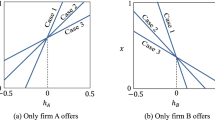Abstract
This work proposes a simple model to simulate the dynamics of the market related to COTS software products, when there are no new entrants. The model takes in explicit account the interactions between products. The model uses a set of random variables, as the initial condition, to simulate the time evolution. The results of the simulations predict the emergence of monopolies, when the interactions between products are significant, and of open markets, when they are limited. The model is validated, by comparing the results of the simulation with the well established observations related to software markets and by comparing the resulting distribution of COTS software products with real data on the software market, which was provided by PC Data Inc.
Similar content being viewed by others
References
Aksit, M., Marcelloni F., Tekinerdogan B., van den Berg, K., & van den Broek, pp. (1997). Active software artifacts. In J. Bosch & S. Mitchell (Eds.), Object-oriented technology (pp. 307–310, LNCS 1357). Berlin Heidelberg New York: Springer.
Baker, J. B., & Bresnahan, T. F. (1988). Estimating the residual demand curve facing a single firm. International Journal of Industiral Organization, 6, 283–300.
Boehm, B. W. (1981). Software engineering economics. Englewood Cliffs, NJ: Prentice Hall.
Bollobas, B. (1985). Random graphs. London: Academic.
Dasgupta, C. G., Dispensa, G. S., & Ghose, S. (1994). Comparing the predictive performance of a neural network model with some traditional market response models. International Journal of Forecasting, 10.
Economides, N. (1996). The economics of networks. International Journal of Industrial Organization, 16(4).
Economides, N. (1999). Competition and vertical integration in the computing industry. In J. A. Eisenach & T. M. Lenard (Eds.), Competition, innovation, and the role of antitrust in the digital marketplace. Norwell, MA: Kluwer.
Economides, N. (2000). Durable goods monopoly with network externalities with application to the PC operating systems market. Quarterly Journal of Electronic Commerce, 1(3).
European Community (1991). Directive on the legal protection of computer programs.
Gandal, N. (1994). Hedonic price indexes for spreadsheets and an empirical test for network externalities. RAND Journal of Economics, 25, 160–170.
Garcia-Diaz, A., & Phillips, D. T. (1995). Principles of experimental design and analysis. London: Chapman & Hall.
Kaniovski, Y., Narduzzo, A., Rossi, A., Taufer, E., & Zaninotto, E. (1999). Diffusion of technologies via economic agents with heterogeneous decision rules. Proceedings of the 4th International Workshop on Economics with Heterogeneous Interacting Agents. Genova, Italy.
PC Data Inc. (1998). June 1998 retail software report. http://www.PC Data.com/.
PC Data Inc. (1999). January 1999 retail software report. http://www.PC Data.com/.
Peter, J. P., & Olson, J. C. (1998). Consumer behavior and marketing strategy. New York: McGraw-Hill.
Positive Support Review (2000). Browser market share study. http://www.psrinc.com/.
Schroeder, M. (1992). Fractals, chaos, power laws: Minutes from an infinite paradise. Nashville, TN: Freeman.
Shapiro, C., & Varian, H. R. (1998). Information rules: A strategic guide to network economy. Boston, MA: Harvard Business School Press.
Steen, F., & Salvanes, K. G. (1999). Testing for market power using a dynamic oligopoly model. International Journal of Industrial Organisation, 17(1), 147–177.
Weil, N. (1999). Sun to offer Star Division office apps for free. Inforworld, 8/31, http://www.infoworld.com/cgi-bin/displayStory.pl?990831.pistarportal.htm.
Westrap, F. V., & Wendt, O. (2000). Diffusion follows structure-a network of the software market. Proceedings of the 33rd Hawaii International Conference on System Sciences.
Author information
Authors and Affiliations
Corresponding author
Rights and permissions
About this article
Cite this article
Marchesi, M., Succi, G. & Russo, B. A model of the dynamics of the market of COTS software, in the absence of new entrants. Inf Syst Front 9, 257–265 (2007). https://doi.org/10.1007/s10796-007-9025-8
Received:
Revised:
Accepted:
Published:
Issue Date:
DOI: https://doi.org/10.1007/s10796-007-9025-8




